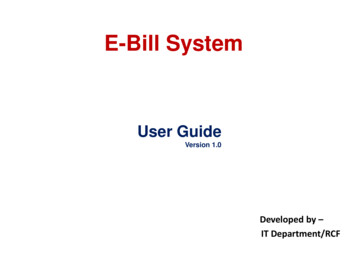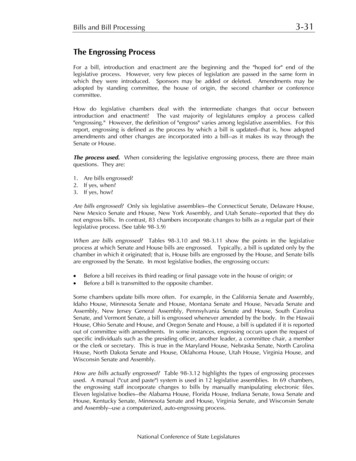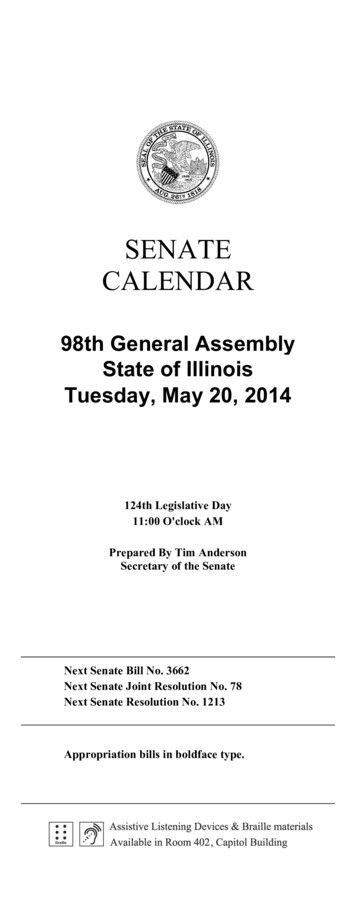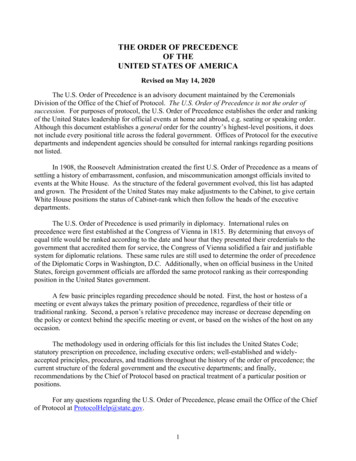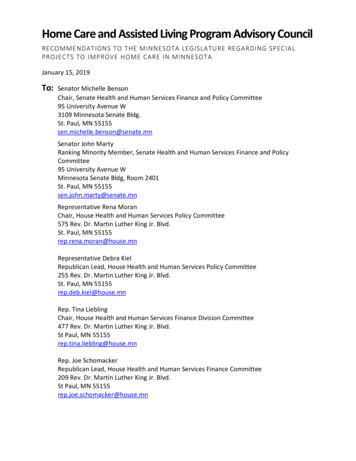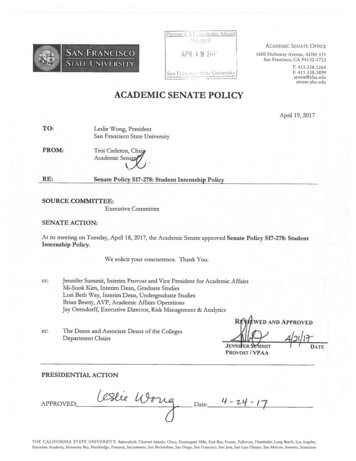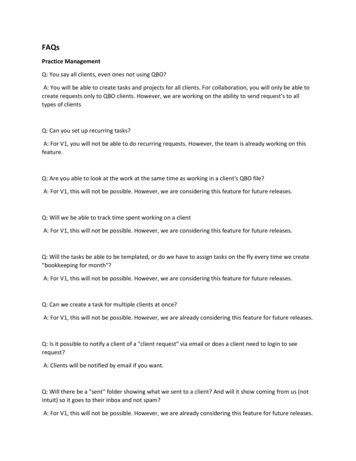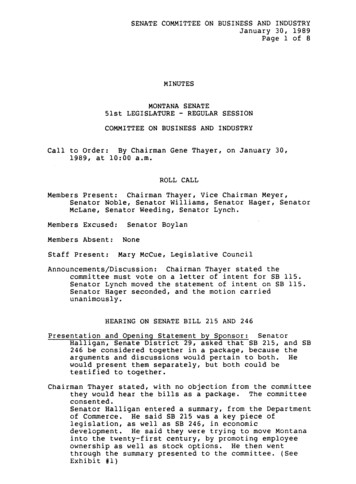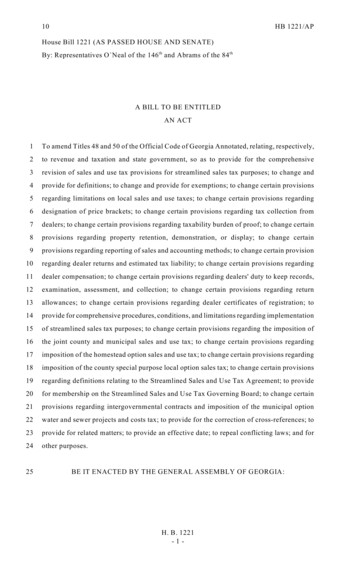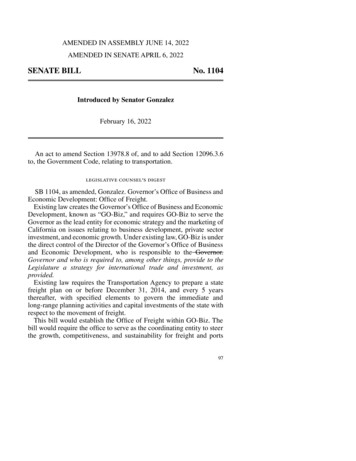
Transcription
AMENDED IN ASSEMBLY JUNE 14, 2022AMENDED IN SENATE APRIL 6, 2022SENATE BILLNo. 1104Introduced by Senator GonzalezFebruary 16, 2022An act to amend Section 13978.8 of, and to add Section 12096.3.6to, the Government Code, relating to transportation.legislative counsel’s digestSB 1104, as amended, Gonzalez. Governor’s Office of Business andEconomic Development: Office of Freight.Existing law creates the Governor’s Office of Business and EconomicDevelopment, known as “GO-Biz,” and requires GO-Biz to serve theGovernor as the lead entity for economic strategy and the marketing ofCalifornia on issues relating to business development, private sectorinvestment, and economic growth. Under existing law, GO-Biz is underthe direct control of the Director of the Governor’s Office of Businessand Economic Development, who is responsible to the Governor.Governor and who is required to, among other things, provide to theLegislature a strategy for international trade and investment, asprovided.Existing law requires the Transportation Agency to prepare a statefreight plan on or before December 31, 2014, and every 5 yearsthereafter, with specified elements to govern the immediate andlong-range planning activities and capital investments of the state withrespect to the movement of freight.This bill would establish the Office of Freight within GO-Biz. Thebill would require the office to serve as the coordinating entity to steerthe growth, competitiveness, and sustainability for freight and ports97
SB 1104—2—across the state and to promote and assess the continued economicvitality and sustainability of the freight sector. The bill would requirethe Governor to appoint a director to (1) oversee the Office of Freight,(2) facilitate collaboration along the supply chain, and (3) advocatefor the interests of business and industry in the freight sector. The billwould require the Office of Freight to meet with specified state agenciesas necessary to address and discuss ongoing freight and supply chainissues and would authorize the Office of Freight to establish andconvene stakeholder advisory groups, as provided. The bill wouldrequire the office, Office of Freight in coordination consultation withspecified state agencies, to prepare an assessment of statewide economicgrowth, competitiveness, prosperity, resiliency, and sustainability forthe state’s freight sector. The bill would require the office GO-Biz tosubmit the assessment to the Legislature on or before December 31,2024, and an updated assessment at least once every 5 years thereafter.thereafter, and would also require GO-Biz to use the assessment toinform the development of, and recommended actions included within,the strategy for international trade and investment, as provided. Thebill would require the Transportation Agency to incorporate the findingsof the assessment into the state freight plan, as specified.Vote: majority. Appropriation: no. Fiscal committee: yes. State-mandated local program: no. The people of the State of California do enact as follows:line 1line 2line 3line 4line 5line 6line 7line 8line 9line 10line 11line 12line 13line 14line 15SECTION 1. Section 12096.3.6 is added to the GovernmentCode, to read:12096.3.6. (a) For purposes of this section, the followingdefinitions apply:(1) “Economic competitiveness” means the ability of theCalifornia freight sector to successfully compete with freightsectors in other states as measured by using existing comparablemetrics, to increase the productivity of freight and related sectors,and to contribute to the growth of the state’s economy. Economiccompetitiveness is affected by policies, institutions, andinvestments that influence the freight sector’s productivity.(2) “Freight sector” means all transportation-based andtransportation-dependent enterprises involved in the supply chainfrom point of origin to point of consumption, including ports, rail,freight corridors, and warehouses and distribution centers.97
—3—line 1line 2line 3line 4line 5line 6line 7line 8line 9line 10line 11line 12line 13line 14line 15line 16line 17line 18line 19line 20line 21line 22line 23line 24line 25line 26line 27line 28line 29line 30line 31line 32line 33line 34line 35line 36line 37line 38line 39line 40SB 1104(3) “Supply chain” means participants in the economic supplychain of this state, including, but not limited to, seaports, airports,land ports of entry, air carriers, motor carriers, ocean carriers,rail carriers, marine terminals, rail terminals, trucking terminals,warehouses, the agriculture industry, manufacturers, and retailers.(b) The Office of Freight is hereby established within theGovernor’s Office of Business and Economic Development. TheOffice of Freight shall serve as the coordinating entity to steer thegrowth, competitiveness, and sustainability for freight and portsacross the state, and shall promote and assess the continuedeconomic vitality and sustainability of the freight sector.(c) The Governor shall appoint a director of the Office ofFreight who shall oversee the Office of Freight, facilitatecollaboration along the supply chain, and advocate for the interestsof business and industry in the freight sector. The director of theOffice of Freight shall have experience in commerce, trade, andcross-cutting supply chain management.(d) (1) The Office of Freight, the California TransportationCommission, the Transportation Agency, the Department ofTransportation, and the State Air Resources Board shall meet asnecessary to address and discuss ongoing freight and supply chainissues.(2) The Office of Freight, in consultation with the Director ofthe Governor’s Office of Business and Economic Development,may establish and convene one or more stakeholder advisorygroups to help inform the work of the Office of Freight inimplementing its mission and duties.(c)(e) (1) The Office of Freight, in coordination consultation withthe State Air Resources Board, the California TransportationCommission, the Department of Transportation, and theTransportation Agency, shall prepare an assessment of statewideeconomic growth, competitiveness, prosperity, resiliency, andsustainability for the state’s freight sector.(2) Notwithstanding Section 10231.5, the office Governor’sOffice of Business and Economic Development shall submit theassessment to the Legislature on or before December 31, 2024,and an updated assessment at least once every five years thereafter.The assessment shall be submitted in compliance with Section9795.97
SB 1104line 1line 2line 3line 4line 5line 6line 7line 8line 9line 10line 11line 12line 13line 14line 15line 16line 17line 18line 19line 20line 21line 22line 23line 24line 25line 26line 27line 28line 29line 30line 31line 32line 33line 34line 35line 36line 37line 38line 39—4—(d)(f) In developing the assessment, the Office of Freight shall doall of the following:(1) Consult with a representative cross section of public andprivate sector freight stakeholders, including representatives ofports, shippers, carriers, freight-related associations, supply chainbusinesses, the freight industry workforce, the Public UtilitiesCommission, the State Lands Commission, academic and researchinstitutions, local air pollution control districts, environmental,safety, and community organizations and representatives fromcommunities that are adjacent to, or environmentally impacted by,the freight sector.(2) Consult with the Legislature.(3) Use the most current data reasonably available to ensure theassessment reflects current market conditions.(4) Consider relevant data and outcomes from the assessmentrequired by Section 14517.(e)(g) The assessment shall do all of the following:(1) Evaluate the resiliency of the state’s freight sector, includingassessing the ongoing needs to address supply chain congestionoutlined in Executive Order No. N-19-21.(2) Expand on the California Sustainable Freight Action Plandeveloped pursuant to Executive Order No. B-32-15, and evaluatethe role and capacity of the freight sector in advancing thezero-emission goals set forth in Executive Order No. N-79-20.(3) Identify Determine the economic competitiveness of allsectors of freight movement along the supply chain. Thisidentification determination shall include an evaluation of thestate’s supply chain competitiveness, international trade andexports, manufacturing, warehousing, distribution centers, capacityto expand, defense, and workforce development, that to the extenteach of these may impact businesses, workers, and communitiesas they relate to the freight industry.(4) Identify metrics and baselines from which to measure theeffectiveness of the goals, recommendations, and actions proposedin the assessment, including, but not limited to, assessment insupporting financial performance, market share performance,workforce development, positive labor market effects, emerging97
—5—line 1line 2line 3line 4line 5line 6line 7line 8line 9line 10line 11line 12line 13line 14line 15line 16line 17line 18line 19line 20line 21line 22line 23line 24line 25line 26line 27line 28line 29line 30line 31line 32line 33line 34line 35line 36line 37line 38line 39SB 1104technologies including logistics, and overall short- and long-termeconomic performance of the freight sector.(5) Assess the relative competitiveness and resiliency of differentsectors of the supply chain, the impacts of trends in the economyacross the supply chain, and the impacts of how economiccompetitiveness for businesses and the freight sector can besupported under state and federal climate and air pollution policieson economic competitiveness for businesses and the freight sector.policies.(6) Identify goals to increase economic competitiveness andstrengthen resilience to economic downturns and the effects ofclimate change.(7) Identify Determine a process to track, at least annually,progress being made to reach the goals and implement therecommendations and other actions proposed in the assessment.This process shall include a mechanism for modifying those goalsand actions to address immediate and emerging issues,stay-at-home orders, or other crises that may impact thecompetitiveness of the freight sector.(8) Identify ongoing strategies the state is employing to addressfreight mobility issues, such as congestion, truck bottlenecks,inefficiencies, and a deficit of workforce, and prioritize andrecommend to the California Transportation Commission and theTransportation Agency complementary or additional strategies toreduce these mobility issues.(9) Identify challenges the California freight sector faces inmeeting the state’s emission reduction goals, quantify the costsassociated with meeting those emission reduction goals, andprioritize and recommend strategies the state can use to addressthese challenges.(10) Include a data sheet indicating the source of the data andthe time period that the data reflects.(h) The assessment shall be used by the Governor’s Office ofBusiness and Economic Development to inform the developmentof, and recommended actions included within, the strategy forinternational trade and investment, prepared pursuant to Section13996.55.SEC. 2. Section 13978.8 of the Government Code is amendedto read:97
SB 1104line 1line 2line 3line 4line 5line 6line 7line 8line 9line 10line 11line 12line 13line 14line 15line 16line 17line 18line 19line 20line 21line 22line 23line 24line 25line 26line 27line 28line 29line 30line 31line 32line 33line 34line 35line 36line 37line 38line 39—6—13978.8. (a) The Transportation Agency shall prepare a statefreight plan. The state freight plan shall comply with the relevantprovisions of the federal Moving Ahead for Progress in the 21stCentury Act (MAP-21), Public Law 112-141. The agency shalldevelop a state freight plan that provides a comprehensive plan togovern the immediate and long-range planning activities and capitalinvestments of the state with respect to the movement of freight.(b) (1) The agency shall establish a freight advisory committeeconsisting of a representative cross section of public and privatesector freight stakeholders, including representatives of ports,shippers, carriers, freight-related associations, the freight industryworkforce, the California Transportation Commission, theDepartment of Transportation, the Public Utilities Commission,the State Lands Commission, the State Air Resources Board,regional and local governments, and environmental, safety, andcommunity organizations.(2) The freight advisory committee shall do all of the following:(A) Advise the agency on freight-related priorities, issues,projects, and funding needs.(B) Serve as a forum for discussion for state transportationdecisions affecting freight mobility.(C) Communicate and coordinate regional priorities with otherorganizations.(D) Promote the sharing of information between the private andpublic sectors on freight issues.(E) Participate in the development of the state freight plan.(c) The state freight plan shall include, at a minimum, all of thefollowing:(1) An identification of significant freight system trends, needs,and issues.(2) A description of the freight policies, strategies, andperformance measures that will guide freight-related transportationinvestment decisions.(3) A description of how the state freight plan will improve theability of California to meet the national freight goals establishedunder Section 167 of Title 23 of the United States Code.(4) Evidence of consideration of innovative technologies andoperational strategies, including intelligent transportation systems,that improve the safety and efficiency of freight movement.97
—7—line 1line 2line 3line 4line 5line 6line 7line 8line 9line 10line 11line 12line 13line 14line 15line 16line 17line 18line 19line 20line 21line 22line 23line 24line 25line 26line 27line 28line 29line 30line 31line 32line 33line 34SB 1104(5) In the case of routes on which travel by heavy vehicles,including mining, agricultural, energy cargo or equipment, andtimber vehicles, is projected to substantially deteriorate thecondition of roadways, a description of improvements that maybe required to reduce or impede the deterioration.(6) An inventory of facilities with freight mobility issues, suchas truck bottlenecks within California, and a description of thestrategies California is employing to address those freight mobilityissues.(7) A description of needed infrastructure, projects, andoperations for the deployment of zero-emission medium- andheavy-duty vehicles and the development of freight corridorsidentified pursuant to Section 14517.(8) Beginning with the state freight plan due on or beforeDecember 31, 2029, and each state freight plan thereafter, thefindings of the assessment prepared pursuant to Section 12096.3.6.(d) Notwithstanding Section 10231.5, the state freight plan shallbe submitted to the Legislature, the Governor, the CaliforniaTransportation Commission, the Public Utilities Commission, andthe State Air Resources Board on or before December 31, 2014,and every five years thereafter. The state freight plan shall besubmitted pursuant to Section 9795.(e) The state freight plan required by this section may bedeveloped separately from, or incorporated into, the statewidestrategic long-range transportation plan required by Section 135of Title 23 of the United States Code.(f) The freight rail element of the state freight plan may bedeveloped separately from, or incorporated into, the state rail planprepared by the Department of Transportation pursuant to Section14036.(g) The Transportation Agency shall incorporate the findingsof the assessment prepared pursuant to Section 12096.3.6 into thestate freight plan that is due on or before December 31, 2024, asan addendum by December 31, 2024.O97
Governor as the lead entity for economic strate gy and the mark eting of California on issues relating to business development, private sector investment, and economic gro wth. Under e xisting la w, GO-Biz is under the direct control of the Director of the Governor's Office of Business and Economic Development, who is responsible to the Governor.

